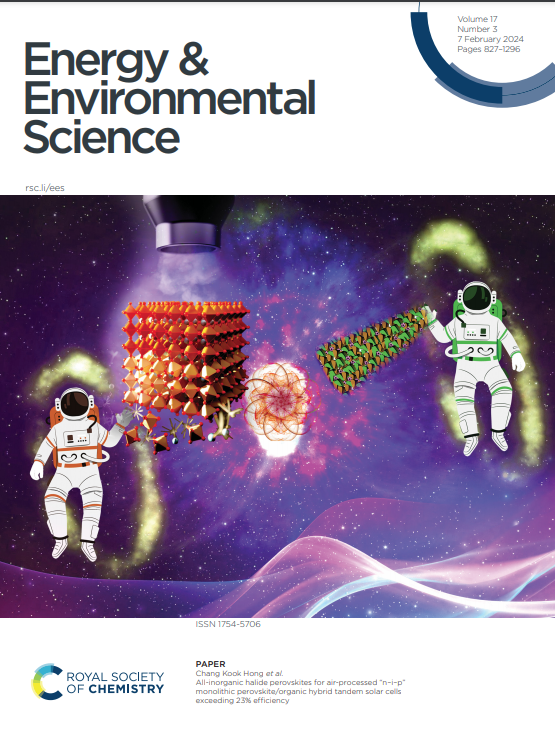Engineering ion-pumping solid electrolyte interphase for ultra-stable aqueous zinc-ion batteries under deep discharge conditions
IF 30.8
1区 材料科学
Q1 CHEMISTRY, MULTIDISCIPLINARY
引用次数: 0
Abstract
Meeting the global terawatt-scale energy demands necessitates innovative solutions to overcome the critical challenges facing aqueous Zn-ion batteries, particularly the poor reversibility and unstable plating/stripping of Zn anodes under high depths of discharge (DOD). In this work, we introduce a novel composite artificial solid-electrolyte interphase (SEI), termed P-G, which combines a poly(ether-block-amide) matrix with graphene oxide (GO). By leveraging the functional groups of the polymer (C=O, C–O–C) and the electronegativity of GO, the P-G SEI layer acts as a highly efficient Zn2+ ion pump, achieving a remarkable Zn2+ transfer number of 0.77 and fast ion transport kinetics. Comprehensive theoretical and experimental analyses demonstrate that the P-G SEI layer regulates Zn2+ coordination and forms rapid ion transport pathways, leading to a highly stable and reversible Zn anode. As a result, P-G@Zn symmetric cells achieve ultra-stable cycling for 6500 hours at 1 mA·cm-2 and a record-breaking lifespan exceeding 5000 hours at 54.7% DOD. Furthermore, a high-specific-energy P-G@Zn||I2 pouch cell delivers exceptional performance, retaining 82.8% capacity after 400 cycles with an N/P ratio of 2. This study offers a compelling framework for designing advanced composite SEI layer, paving the way for highly reversible Zn-ion batteries in practical energy storage applications.深度放电条件下超稳定水锌离子电池的工程离子泵送固体电解质界面
为了满足全球太瓦规模的能源需求,需要创新的解决方案来克服水性锌离子电池面临的关键挑战,特别是在高放电深度(DOD)下,锌阳极的可逆性差和镀/剥离不稳定。在这项工作中,我们介绍了一种新的复合人工固体电解质界面(SEI),称为P-G,它将聚醚-块酰胺(聚醚-块酰胺)基质与氧化石墨烯(氧化石墨烯)结合在一起。P-G SEI层利用聚合物的官能团(C=O, C - O - C)和氧化石墨烯的电负性,作为高效的Zn2+离子泵,实现了0.77的Zn2+转移数和快速的离子传输动力学。综合理论和实验分析表明,P-G SEI层调节Zn2+配位,形成快速离子传输通道,形成高度稳定可逆的Zn阳极。因此,P-G@Zn对称电池在1 mA·cm-2下实现了6500小时的超稳定循环,在54.7% DOD下实现了超过5000小时的破纪录寿命。此外,高比能P-G@Zn||I2袋状电池具有出色的性能,在400次循环后保持82.8%的容量,N/P比为2。该研究为设计先进的复合SEI层提供了一个引人注目的框架,为实际储能应用中的高可逆锌离子电池铺平了道路。
本文章由计算机程序翻译,如有差异,请以英文原文为准。
求助全文
约1分钟内获得全文
求助全文
来源期刊

Energy & Environmental Science
化学-工程:化工
CiteScore
50.50
自引率
2.20%
发文量
349
审稿时长
2.2 months
期刊介绍:
Energy & Environmental Science, a peer-reviewed scientific journal, publishes original research and review articles covering interdisciplinary topics in the (bio)chemical and (bio)physical sciences, as well as chemical engineering disciplines. Published monthly by the Royal Society of Chemistry (RSC), a not-for-profit publisher, Energy & Environmental Science is recognized as a leading journal. It boasts an impressive impact factor of 8.500 as of 2009, ranking 8th among 140 journals in the category "Chemistry, Multidisciplinary," second among 71 journals in "Energy & Fuels," second among 128 journals in "Engineering, Chemical," and first among 181 scientific journals in "Environmental Sciences."
Energy & Environmental Science publishes various types of articles, including Research Papers (original scientific work), Review Articles, Perspectives, and Minireviews (feature review-type articles of broad interest), Communications (original scientific work of an urgent nature), Opinions (personal, often speculative viewpoints or hypotheses on current topics), and Analysis Articles (in-depth examination of energy-related issues).
 求助内容:
求助内容: 应助结果提醒方式:
应助结果提醒方式:


